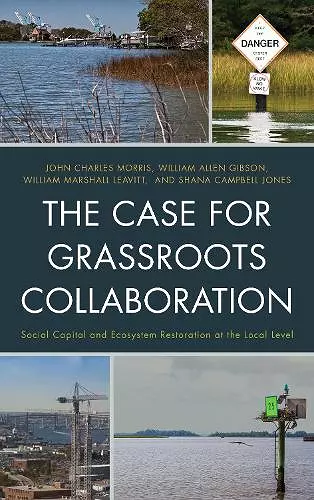The Case for Grassroots Collaboration
Social Capital and Ecosystem Restoration at the Local Level
John C Morris author William Allen Gibson author William Marshall Leavitt author Shana Campbell Jones author
Format:Hardback
Publisher:Lexington Books
Published:26th Sep '13
Currently unavailable, and unfortunately no date known when it will be back
This hardback is available in another edition too:
- Paperback£44.00(9781498515337)

The nation’s approach to managing environmental policy and protecting natural resources has shifted from the national government’s top down, command and control, regulatory approach, used almost exclusively in the 1970s, to collaborative, multi-sector approaches used in recent decades to manage problems that are generally too complex, too expensive,, and too politically divisive for one agency to manage or resolve on its own. Governments have organized multi-sector collaborations as a way to achieve better results for the past two decades. We know much about why collaboration occurs. We know a good deal about how collaborative processes work. Collaborations organized, led, and managed by grassroots organizations are rarer, though becoming more common. We do not as yet have a clear understanding of how they might differ from government led collaborations. Hampton Roads, Virginia, located at the southern end of the Chesapeake Bay, offers an unusual opportunity to study and draw comparative lessons from three grassroots environmental collaborations to restore three rivers in the watershed, in terms of how they build, organize and distribute social capital, deepen democratic values, and succeed in meeting ecosystem restoration goals and benchmarks. This is relevant for the entire Chesapeake Bay watershed, but is also relevant for understanding grassroots collaborative options for managing, protecting, and restoring watersheds throughout the U.S. It may also provide useful information for developing grassroots collaborations in other policy sectors. The premise underlying this work is that to continue making progress toward achieving substantive environmental outcomes in a world where the problems are complex, expensive, and politically divisive, more non-state stakeholders must be actively involved in defining the problems and developing solutions. This will require more multi-sector collaborations of the type that governments have increasingly relied on for the past two decades. Our approach examines one subset of environmental collaboration, those driven and managed by grassroots organizations that were established to address specific environmental problems and provide implementable solutions to those problems, so that we may draw lessons that inform other grassroots collaborative efforts.
The idea of participatory democracy and citizen involvement in agency decision making is not new. This is especially true for works on participatory decision making in environmental policy and watershed management. Unfortunately, what sounds like a great idea on the surface rarely works in practice as competing interests often get in the way of compromise and collaboration. This is where The Case for Grassroots Collaboration can prove to be a useful addition to the literature. The authors provide three case studies of situations where the approach did work--the Elizabeth River watershed, the Lynnhaven River watershed, and the Nansemond River watershed. . . .The authors synthesize the factors that led to success in these cases in order to provide a template for future use. This is what is necessary if citizens and policy makers are to bridge the gap between a promising theory and a generally elusive practice and make more widespread use of grassroots participation. For this reason, the work is recommended. Summing Up: Recommended. Lower-division undergraduate collections and above. * CHOICE *
This is a richly detailed and carefully supported examination of an under-explored aspect of environmental protection, the role of grassroots organizations. The work is particularly valuable for the specific, well-documented characterizations of these organizations. The mix of history and interpretation, which constitute the heart of the book, is especially noteworthy. This mix provides the necessary scholarly framework within which the reader can place the concrete details that draw the reader into the content deeply. The Case for Grassroots Collaboration has the potential to add to the field's knowledge of an important yet emerging topic. -- Gerald Andrews Emison, Mississippi State University
This work offers a fresh perspective on collaboration by focusing on citizen-based efforts to resolve complex problems. An in-depth examination of three grassroots environmental organizations reveals the power in voluntary collaboration as a catalyst for action. -- Madeleine W. McNamara, University of New Orleans
The Case for Grassroots Collaboration brings together the most current research on environmental collaboration, with a special focus on the potential of local, place-based initiatives to make a significant difference in ecological restoration efforts, such as the Chesapeake Bay. The book’s major theme, “restoring water quality one watershed at a time,” richly illustrated by three in-depth case studies, inspires hope for those discouraged by the limited success of government-led, large-scale environmental collaboration. The message, supported by evidence from these case studies, is that small successes in improving water quality support gains on a larger scale. The rich detail in the case studies, framed by current literature, is valuable to academic researchers, and accessible to citizens who are inspired by their own sense of place to make a difference. -- Christine Reed, University of Nebraska-Omaha
ISBN: 9780739176962
Dimensions: 237mm x 159mm x 26mm
Weight: 562g
284 pages